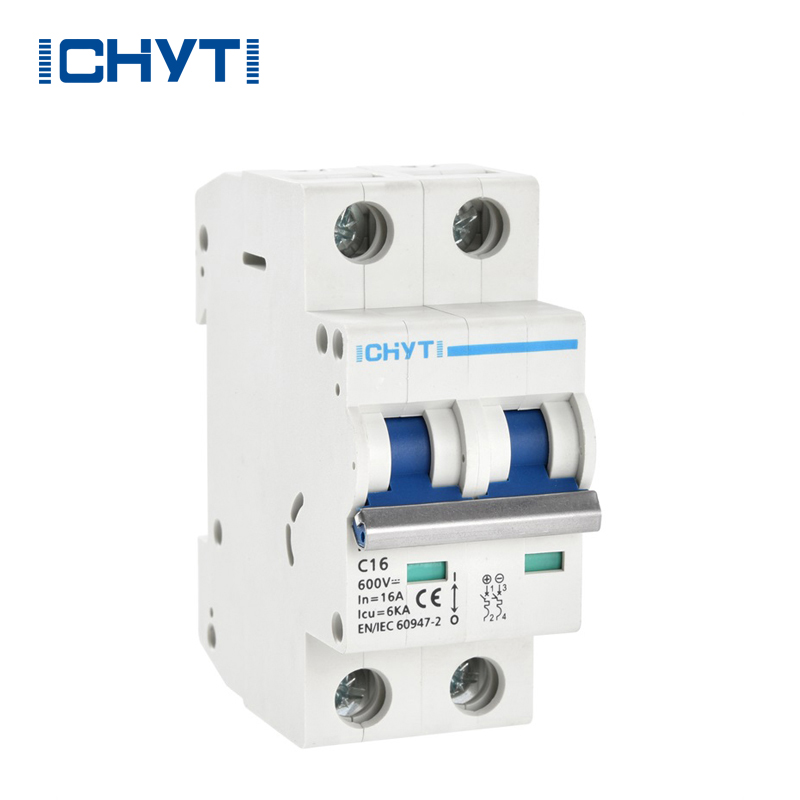PV DC Circuit Breaker: Ensuring Safety in Solar Power Systems
2025-05-06
As the world transitions towards more sustainable energy sources, solar power has become a dominant player in the renewable energy landscape. Solar power systems are becoming increasingly common, whether for residential, commercial, or industrial use. However, as with any electrical system, ensuring safety and reliability is of paramount importance. One essential component in solar power systems is the PV DC circuit breaker. This device plays a crucial role in protecting the solar power system, preventing electrical hazards, and ensuring the system operates safely and efficiently.

What is a PV DC Circuit Breaker?
A PV DC circuit breaker is a type of electrical protective device specifically designed for photovoltaic (PV) systems. Unlike traditional AC circuit breakers, which are used to protect alternating current (AC) circuits, PV DC circuit breakers are engineered to work with direct current (DC), which is the type of electricity generated by solar panels. Their primary function is to disconnect the electrical flow when there is an overload, short circuit, or fault in the system, preventing damage to the system's components or reducing the risk of electrical fires.
Why is a PV DC Circuit Breaker Necessary?
The unique characteristics of photovoltaic systems necessitate the use of DC circuit breakers. Here’s why they are indispensable in solar power systems:
1. DC Current Characteristics
Solar panels produce DC electricity, which behaves differently from AC electricity. DC current flows in a steady, unidirectional manner, and when a circuit is interrupted, it can cause an electric arc. Unlike AC, which naturally crosses zero voltage at regular intervals, DC can maintain an arc even after the circuit is opened. This makes it more challenging to break the circuit safely, which is why specialized DC circuit breakers are required in PV systems.
2. Overload and Short Circuit Protection
The main function of a PV DC circuit breaker is to protect the system from overloads and short circuits. If a fault occurs, such as a sudden surge in current, the breaker automatically disconnects the circuit, preventing further damage to the solar panels, wiring, or inverter. Without this protection, the system would be vulnerable to overheating, fires, or irreversible damage to expensive components.
3. System Longevity
By ensuring that the system is protected from electrical faults, PV DC circuit breakers help extend the lifespan of the entire solar power system. Protecting the inverter and solar panels from damage not only maintains system efficiency but also reduces repair or replacement costs.
4. Compliance with Safety Standards
Many countries and regions require the installation of PV DC circuit breakers to meet safety standards and regulations. These regulations ensure that solar power systems are safely installed and maintained, reducing the risk of electrical hazards to both the system owner and the general public.
How Does a PV DC Circuit Breaker Work?
The operation of a PV DC circuit breaker is similar to that of a standard circuit breaker but is adapted to handle the unique challenges of DC electrical circuits:
1. Normal Operation
Under normal operating conditions, the circuit breaker remains closed, allowing the flow of electricity from the solar panels to the inverter and other components. The breaker is designed to allow a continuous flow of DC current without any interruption, as long as everything operates within normal parameters.
2. Overload or Short Circuit
If there is an overload (excessive current) or a short circuit (an unintended connection between wires), the breaker detects this anomaly and reacts by opening the circuit. This action stops the flow of electricity and prevents potential damage to the system.
3. Arc Suppression
When interrupting DC circuits, the circuit breaker must deal with the issue of electric arcs. Unlike AC systems where the current naturally drops to zero, DC arcs tend to persist. PV DC circuit breakers are equipped with mechanisms like arc chutes, resistors, or magnetic fields that help extinguish the arc as quickly as possible, ensuring that the circuit is safely interrupted.
Key Features of PV DC Circuit Breakers
1. Rated Voltage and Current
PV DC circuit breakers are designed to handle specific voltage and current ratings based on the requirements of the solar power system. These breakers are available in a range of ratings, ensuring compatibility with different solar panel configurations and system sizes.
2. Arc Extinguishing Mechanism
As mentioned, one of the critical features of a PV DC circuit breaker is its ability to handle the arc generated by DC current. These breakers often include advanced arc-extinguishing technology to safely break the circuit without causing damage or hazards.
3. Manual and Automatic Operation
Some PV DC circuit breakers can be operated manually, allowing technicians to disconnect the system during maintenance or installation. Others are designed for automatic operation, immediately cutting off the circuit in the event of a fault, ensuring that the system remains safe without manual intervention.
4. Durability and Reliability
PV DC circuit breakers are built to last, with high-quality materials that withstand harsh environmental conditions, including exposure to sunlight, moisture, and temperature fluctuations. These features ensure that the breakers perform reliably over the long term, even in outdoor environments.
Applications of PV DC Circuit Breakers
PV DC circuit breakers are essential components in various parts of a solar power system, including:
1. Solar Panels
Circuit breakers are typically installed on the DC side of solar panels to protect individual panels or strings of panels from damage caused by electrical faults.
2. Inverters
Inverters, which convert DC electricity to AC electricity, require protection from overcurrents. A PV DC circuit breaker is often installed between the solar panels and the inverter to ensure the system is protected from faults in either component.
3. DC Combiner Boxes
In large-scale solar installations, a DC combiner box is used to combine the output from multiple strings of solar panels. Circuit breakers are installed in the combiner box to protect each string of panels and ensure proper functioning.
4. Battery Storage Systems
Solar systems with battery storage also use DC circuit breakers to protect the connections between the panels, inverter, and battery storage units. These breakers help ensure the safe operation of the entire energy storage and distribution system.
Benefits of PV DC Circuit Breakers
1. Enhanced Safety
PV DC circuit breakers ensure the safety of both the solar power system and the people who interact with it. By disconnecting faulty circuits, they prevent electrical fires and damage to the components.
2. Regulatory Compliance
Installing a PV DC circuit breaker is often required to meet local safety standards and regulations for solar installations. This ensures the system complies with best practices for electrical safety.
3. Protection of Investment
Solar power systems represent a significant investment, and protecting that investment is critical. A PV DC circuit breaker helps extend the lifespan of expensive components like the inverter and solar panels by preventing damage from electrical faults.
4. Cost-Effective
Preventing damage to the system through reliable circuit protection reduces maintenance costs and the need for expensive repairs or replacements, making PV DC circuit breakers a cost-effective solution for solar system owners.
Conclusion
A PV DC circuit breaker is a vital component in any photovoltaic system, ensuring that the system operates safely and efficiently. By providing overload, short-circuit, and arc protection, these breakers safeguard the electrical components and help maintain the longevity of the solar power system. Whether for residential, commercial, or industrial applications, a PV DC circuit breaker offers peace of mind, knowing that the system is protected from electrical faults and hazards. As solar energy continues to grow as a primary energy source, the role of these critical protective devices will only become more important.


